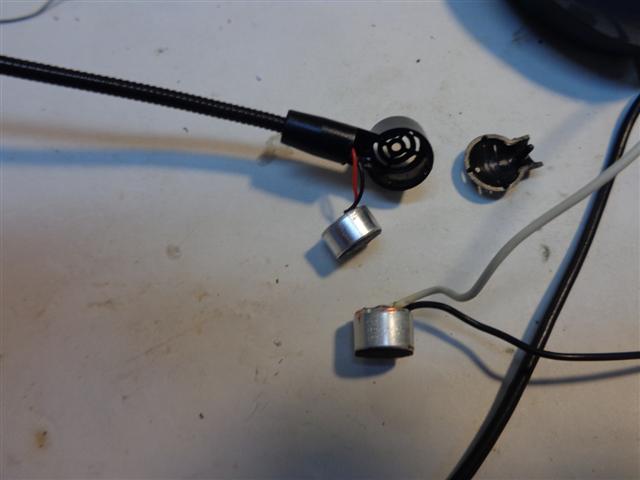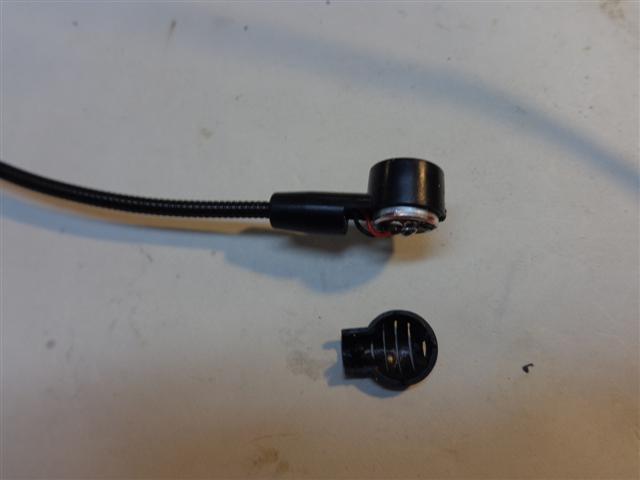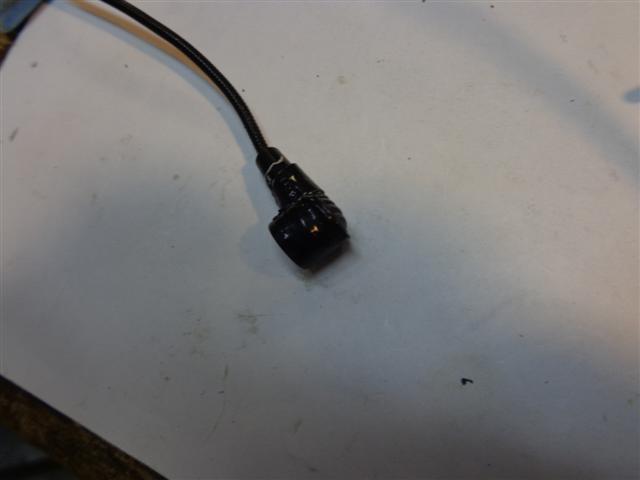Though I'd like to have one, I just can't afford a good wireless mic. But having found a QFX model M-309 wireless mic brand new for $24, I figured I'd see if it might at least be hacked into being usable. Surprisingly, it forms a pretty quiet connection, so from a radio point of view its usable. The big problem is the cheap mic element. It overloads easily if its positioned close to your mouth or you sing loud. I figured the electronic input stage was being overloaded, but I figured I'd start at the mic, and put a scope right across its output, while in circuit. I was surprised to see that when a spoke loudly into it, the output from the raw mic itself was over 2V p-p, and was obviously clipping (probably mechanically clipping). For such a high voltage I assumed I was looking at a ceramic mic element, but since it doesn't output anything without being connected to the transmitter (there's about 7VDC there, maybe its just a high output condenser mic?
In any case, aside from it not being a very directional mic (breath from my nose is picked up way too much), I'm sure i could make it closer to 'usable" if I could figure a way to make the mic element less sensitive. If I take off the foam windscreen and put duct tape over its holes, then its very attenuated and won't distort. But of course then it sounds like you're talking from inside a barrel . I might consider investing in a better mic element if I knew for sure what kind of element it was, but for now can anyone think of a way to acoustically attenuate the response of the mic in such a way that it loses sensitivity to all frequencies approximately the same? remeber... its not the electrical output I need to attenuate... its the mic's raw acoustic sensitivity.
. I might consider investing in a better mic element if I knew for sure what kind of element it was, but for now can anyone think of a way to acoustically attenuate the response of the mic in such a way that it loses sensitivity to all frequencies approximately the same? remeber... its not the electrical output I need to attenuate... its the mic's raw acoustic sensitivity.
Thanks for any creative thoughts!
In any case, aside from it not being a very directional mic (breath from my nose is picked up way too much), I'm sure i could make it closer to 'usable" if I could figure a way to make the mic element less sensitive. If I take off the foam windscreen and put duct tape over its holes, then its very attenuated and won't distort. But of course then it sounds like you're talking from inside a barrel
Thanks for any creative thoughts!
All I can suggest is connect a Shure mic to it instead of the cheap electret mic?
Well I didn't have anything that good to test with, but I think I got lucky! I had another small electret mic I saved from something... possibly a built in mic from an old cassette recorder. Glad i saved it! It was much less sensitive and much better sounding too. It was just slightly larger, but no so large I couldn't hack it in to the original enclosure (see photos). Because its way less sensitive, I can adjust it closer to my mouth and it won't overload, and also doesn't pick up jets of air from my nose as badly.
In any case, its still a long way from a high end system, but its at least usable now.
original disassembled mic, with my better element next to it...

Substituted element...

A little Duct tape

And re-assembled.

Hopefully other musicians on a low budget will benefit from this discussion. This device has now been improved 500%!! I suspect the issue is that the manufacturer used the same mic element for the lapel mic as he did for the head version. A lapel mic would need the extra sensitivity, but for the head version it wasn't a good pick.
- Status
- This old topic is closed. If you want to reopen this topic, contact a moderator using the "Report Post" button.